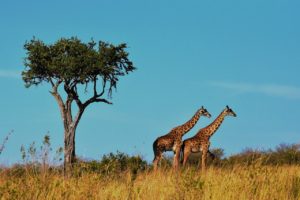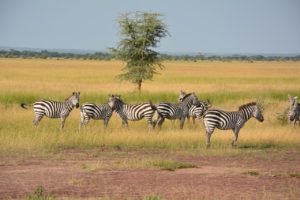Tanzania is located in Southeast Africa. It borders the Indian Ocean to the east, Kenya and Uganda to the north, Rwanda, Burundi, and the Democratic Republic of the Congo to the west, and Zambia, Malawi, and Mozambique to the south. Tanzania has a population of 37 million people. The capital of Tanzania is Dodoma, and the official language is English.
The name “Tanzania” comes from the contraction of Tanganyika and Zanzibar, as a result of the union of these countries in 1964, although they were previously independent nations. For economic reasons, major powers had a great interest in these countries.
The climate in Tanzania is tropical. It is characterized by moderately high temperatures and high humidity in the air. Rainfall is more abundant on the coast and near Lake Victoria and Lake Tanganyika.
From March to May, there is a period of heavier rainfall and storms that make some areas of the country inaccessible. From May to October, it’s a dry season. In November, there is a rainy season that lasts until December, followed by another dry season, but shorter. This way, you can plan the best time to volunteer in Tanzania according to your circumstances and preferences. In this post, we’ll tell you all about visiting one of Tanzania’s jewels: Serengeti National Park.
Serengeti National Park during a volunteer experience in Africa
Going to Serengeti National Park is the dream of any nature and wildlife lover. It is one of the largest parks in Tanzania, covering about 14,763 square kilometers of land, consisting of plains dotted with acacias, wooded savannas, and forests.
Its grasslands are filled with vast kopjes, rocky outcrops like islands on the plain, and rivers flow through the park, providing habitat for a wide variety of birds, mammals, and reptiles.
Serengeti National Park is located on a plateau between the Ngorongoro Highlands. To the north, it borders the Masai Mara National Reserve in Kenya, and to the west, it extends almost to Lake Victoria. The name of the park, Serengeti, means “endless plain” and is derived from the Maasai language.
The Great Migration in Serengeti
Serengeti National Park is a wildlife sanctuary that offers visitors a unique experience throughout the year. However, the migration in Serengeti is the most impressive animal spectacle, as the herds can extend over more than ten kilometers in length and are closely followed by predators.
As the dry season reduces the amount of water in wells and water sources and withers vegetation, millions of wildebeests, antelopes, elephants, gazelles, zebras, giraffes, and other animals head north where there is still water and vegetation. Then they will travel back south when this area has water and fresh grass available again.
This park has the largest population of lions in Africa, as well as leopards, cheetahs, hippos, or crocodiles that take advantage of the Great Migration to feast. If you’re interested in seeing how a lion or cheetah hunts, the Great Migration in Tanzania is the right place to see it during your international volunteer experience!
However, like any other safari in Africa, I have to warn you that this is not a zoo. You don’t always have the luck to see all the animals you want. However, with the large number of animals inhabiting this park, it’s quite easy to see them!
Fauna of Serengeti
The most sought-after animals in any safari are the so-called Big Five. These are the elephant, the African buffalo, the leopard, the lion, and the black rhinoceros.
Serengeti National Park is one of the few parks that has the Big Five, and most of them can be observed relatively frequently. In total, it has approximately 74,000 buffalo, 5,000 elephants, 3,000 lions, and 1,000 buffaloes. However, the population of black rhinos has decreased significantly in recent years and they are very difficult to spot.
Currently, there are only about 130 of these animals left in Serengeti Park due to poaching. Fortunately, South Africa has donated several specimens to Tanzania to help repopulation, and they are beginning to be seen more easily.
In addition to the big five, other predator animals available in large quantities are cheetahs, hyenas, jackals, hippos, crocodiles, wild dogs, the bat-eared fox, the wild cat, the serval, or snakes like the python or the green mamba.
As for herbivores, the blue wildebeest stands out, being the most numerous population in the park. Other animals you can find are gazelles, impalas, giraffes, buffaloes, zebras, topis, antelopes, or baboons, among more than 150 species.
Between July and September, the animals are in the northern section of the park and in the adjacent Masai Mara Game Reserve in Kenya, which is their refuge during the dry season. In mid-September, they head south to reach the short grass plains in the Gol and Hill Nabbi mountains region around December. Those who have survived the long migration route stop in January and February in this area before repeating the search for water and greener pastures in May.
If you want to see animals during your volunteer experience in Africa, Serengeti National Park in Tanzania is an unbeatable destination!






One response to “What to see during your volunteer experience in tanzania: serengeti, the must-visit”
Buenas tardes, quisiera saber el valor y fechas y requisitos para el voluntariado a Tanzania con animales, gracias.